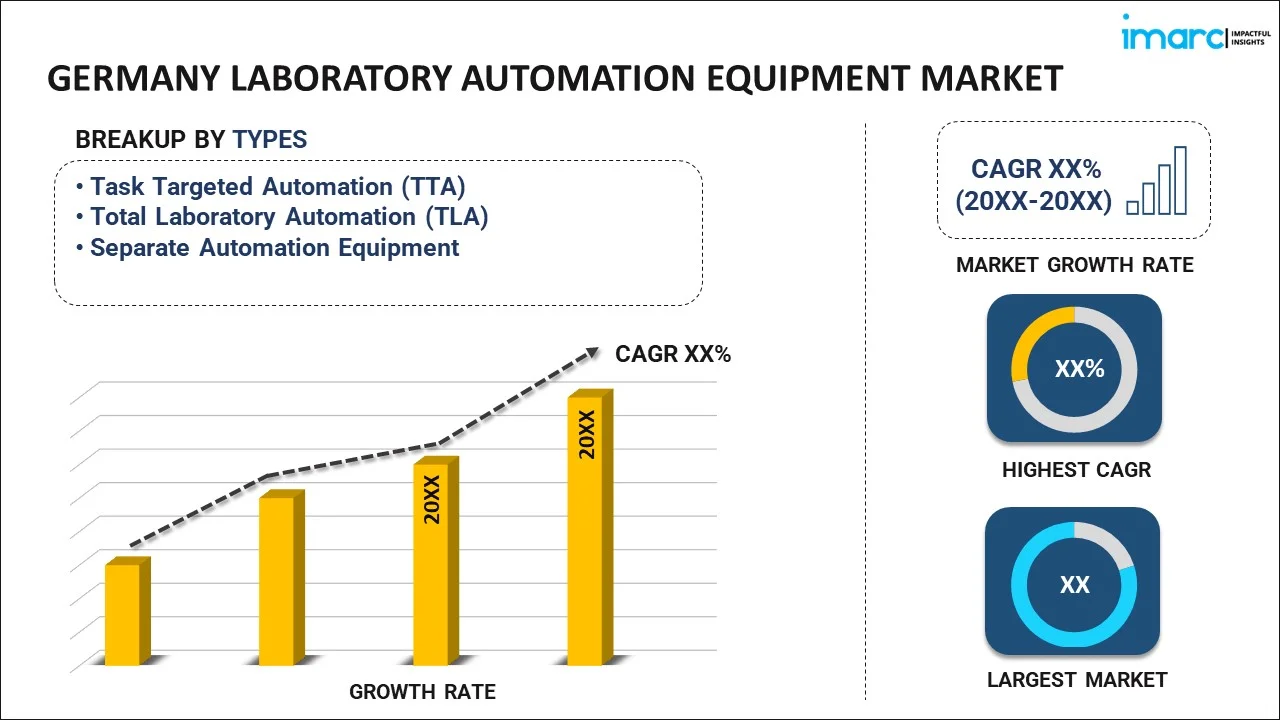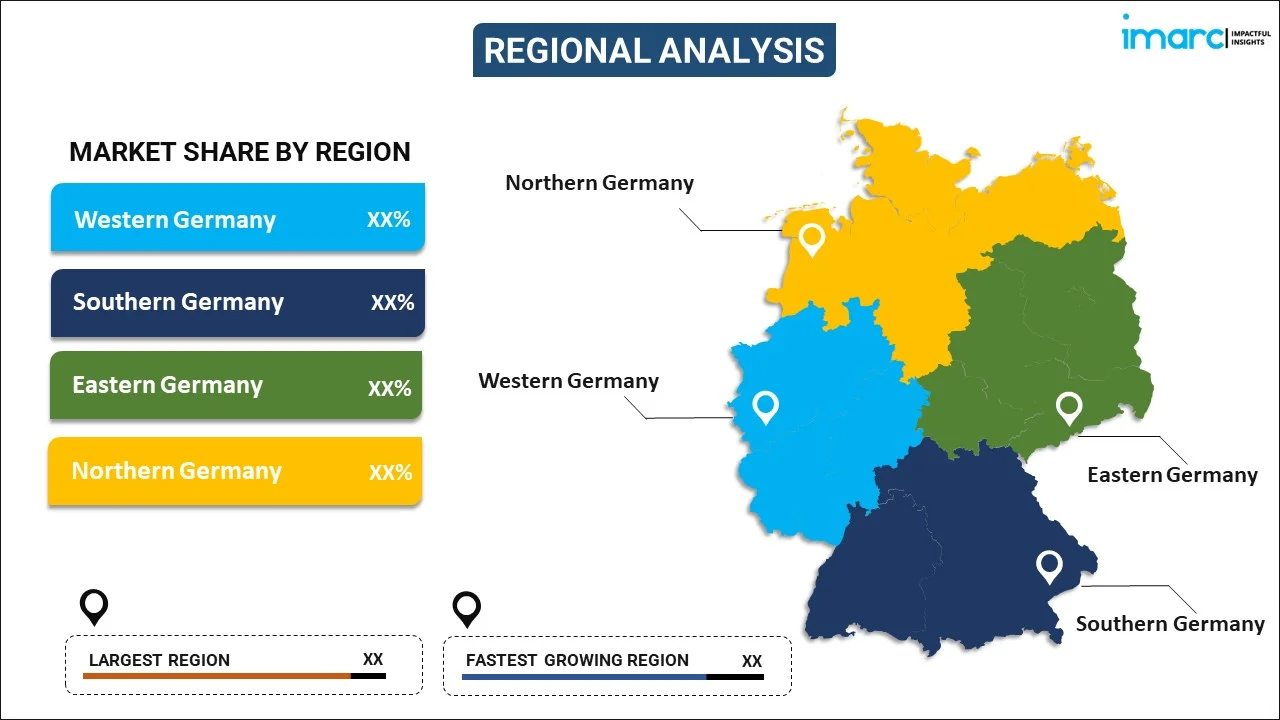
Germany Laboratory Automation Equipment Market Report by Type (Task Targeted Automation (TTA), Total Laboratory Automation (TLA), Separate Automation Equipment), Application (Biotechnology and Pharmaceutical Companies, Hospitals and Diagnostic Laboratories, Research and Academic Institutes), and Region 2024-2032
Germany Laboratory Automation Equipment Market Overview:
The Germany laboratory automation equipment market is projected to exhibit a growth rate (CAGR) of 6.30% during 2024-2032. The need for increased efficiency, accuracy, and throughput in lab processes, advancements in robotics and artificial intelligence (AI), rising demand for high-throughput screening, and the need to reduce human error and operational costs are key factors influencing market growth.
|
Report Attribute
|
Key Statistics
|
|---|---|
|
Base Year
|
2023 |
|
Forecast Years
|
2024-2032
|
|
Historical Years
|
2018-2023
|
| Market Growth Rate (2024-2032) | 6.30% |
Germany Laboratory Automation Equipment Market Trends:
Increasing demand for high-throughput screening (HTS):
High-throughput screening is a critical process in drug discovery and biotechnology, allowing researchers to evaluate thousands of compounds for potential therapeutic effects quickly. Automation equipment significantly enhances HTS by speeding up the screening process, reducing manual labor, and minimizing human error. Automated diagnostic systems make it possible to test large volumes of samples quickly and accurately. This is important in fields like infectious disease testing, where timely results can affect patient outcomes and public health responses, thereby driving market growth. Moreover, the German government's supportive policies and funding for scientific research and technological advancements create a favorable environment for the growth of the market. The presence of key market players and research institutions also fosters innovation and collaboration, leading to the development of cutting-edge automation solutions.
Advancements in robotics and artificial intelligence:
Modern robotic systems are becoming more sophisticated, with capabilities to perform complex tasks with high precision and consistency. Numerous laboratory tasks, such as mixing, data analysis, sample preparation, and pipetting, can be handled by these systems. Automated systems can learn from data, optimize workflows, and even predict outcomes thanks to the integration of machine learning (ML) and artificial intelligence (AI) algorithms. AI-driven automation can streamline decision-making processes, enhance predictive maintenance of equipment, and improve the overall efficiency of laboratory operations. These technological advancements reduce the dependency on human intervention, allowing laboratories to operate continuously and achieve higher productivity levels thus providing an impetus to the market growth.
Growing need for precision and reproducibility in laboratory processes:
Precision and repeatability of findings are critical in both clinical and scientific research. Data reliability may be impacted by the variability introduced by manual sample and reagent handling. Automated systems mitigate these issues by providing consistent handling and precise control over experimental conditions. This is particularly important in regulated environments such as clinical laboratories and pharmaceutical manufacturing, where stringent quality standards must be met. Automation ensures that processes are repeatable and traceable, facilitating compliance with regulatory requirements and enhancing the credibility of research findings. Furthermore, automated systems’ ability to handle and process big datasets, which enhances the effectiveness of data analysis and interpretation is strengthening the market demand in data-intensive fields like proteomics and genomics.
Germany Laboratory Automation Equipment Market News:
- In March 2023, Brooks Automation US, LLC finalized the acquisition of Aim Lab Automation Technologies Pty Ltd., bolstering its offerings in the lab automation sector. This move marks Brooks' expansion into the clinical diagnostics market from drug discovery. Brooks expands its capabilities, broadens its customer base, and fosters stronger customer collaboration by integrating Aim Lab with PreciseFlex.
Germany Laboratory Automation Equipment Market Segmentation:
IMARC Group provides an analysis of the key trends in each segment of the market, along with forecasts at the country level for 2024-2032. Our report has categorized the market based on type and application.
Type Insights:

- Task Targeted Automation (TTA)
- Total Laboratory Automation (TLA)
- Separate Automation Equipment
The report has provided a detailed breakup and analysis of the market based on the type. This includes task targeted automation (TTA), total laboratory automation (TLA), and separate automation equipment.
Application Insights:
- Biotechnology and Pharmaceutical Companies
- Hospitals and Diagnostic Laboratories
- Research and Academic Institutes
A detailed breakup and analysis of the market based on the applications have also been provided in the report. This includes biotechnology and pharmaceutical companies, hospitals and diagnostics laboratories, and research and academic institutes.
Regional Insights:

- Western Germany
- Southern Germany
- Eastern Germany
- Northern Germany
The report has also provided a comprehensive analysis of all the major regional markets, which include Western Germany, Southern Germany, Eastern Germany, and Northern Germany.
Competitive Landscape:
The market research report has also provided a comprehensive analysis of the competitive landscape in the market. Competitive analysis such as market structure, key player positioning, top winning strategies, competitive dashboard, and company evaluation quadrant has been covered in the report. Also, detailed profiles of all major companies have been provided.
Germany Laboratory Automation Equipment Market Report Coverage:
| Report Features | Details |
|---|---|
| Base Year of the Analysis | 2023 |
| Historical Period | 2018-2023 |
| Forecast Period | 2024-2032 |
| Units | US$ Million |
| Scope of the Report | Exploration of Historical Trends and Market Outlook, Industry Catalysts and Challenges, Segment-Wise Historical and Future Market Assessment:
|
| Types Covered | Task Targeted Automation (TTA), Total Laboratory Automation (TLA), Separate Automation Equipment |
| Applications Covered | Biotechnology and Pharmaceutical Companies, Hospitals and Diagnostic Laboratories, Research and Academic Institutes |
| Regions Covered | Western Germany, Southern Germany, Eastern Germany, Northern Germany |
| Customization Scope | 10% Free Customization |
| Post-Sale Analyst Support | 10-12 Weeks |
| Delivery Format | PDF and Excel through Email (We can also provide the editable version of the report in PPT/Word format on special request) |
Key Questions Answered in This Report:
- How has the Germany laboratory automation equipment market performed so far and how will it perform in the coming years?
- What has been the impact of COVID-19 on the Germany laboratory automation equipment market?
- What is the breakup of the Germany laboratory automation equipment market on the basis of type?
- What is the breakup of the Germany laboratory automation equipment market on the basis of application?
- What are the various stages in the value chain of the Germany laboratory automation equipment market?
- What are the key driving factors and challenges in the Germany laboratory automation equipment?
- What is the structure of the Germany laboratory automation equipment market and who are the key players?
- What is the degree of competition in the Germany laboratory automation equipment market?
Key Benefits for Stakeholders:
- IMARC’s industry report offers a comprehensive quantitative analysis of various market segments, historical and current market trends, market forecasts, and dynamics of the Germany laboratory automation equipment market from 2018-2032.
- The research report provides the latest information on the market drivers, challenges, and opportunities in the Germany laboratory automation equipment market.
- Porter's five forces analysis assist stakeholders in assessing the impact of new entrants, competitive rivalry, supplier power, buyer power, and the threat of substitution. It helps stakeholders to analyze the level of competition within the Germany laboratory automation equipment industry and its attractiveness.
- Competitive landscape allows stakeholders to understand their competitive environment and provides an insight into the current positions of key players in the market.
Need more help?
- Speak to our experienced analysts for insights on the current market scenarios.
- Include additional segments and countries to customize the report as per your requirement.
- Gain an unparalleled competitive advantage in your domain by understanding how to utilize the report and positively impacting your operations and revenue.
- For further assistance, please connect with our analysts.
 Inquire Before Buying
Inquire Before Buying
 Speak to an Analyst
Speak to an Analyst
 Request Brochure
Request Brochure
 Request Customization
Request Customization




.webp)




.webp)












